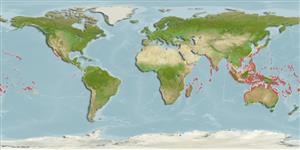Environment: milieu / climate zone / depth range / distribution range
Ecology
Marine; reef-associated; depth range 4 - 16 m (Ref. 90102). Tropical
Indo-Pacific: East Africa to Fr. Polynesia.
Size / Weight / Age
Maturity: Lm ? range ? - ? cm
Max length : 2.7 cm TL male/unsexed; (Ref. 90102)
Short description
Identification keys | Morphology | Morphometrics
Dorsal spines (total): 6 - 7; Dorsal soft rays (total): 9; Anal spines: 1; Anal soft rays: 8. Characterized by white body color with irregular brown spotting; pelvic fins slightly united medially; absence of pelvic frenum; rounded caudal fin; longitudinal scale series 22; absence of scales on head and anterior body; cycloid scales embedded on posterior half of body; depth of body 6.3 in SL (Ref. 90102).
Inhabits reef crevices in 4-16 m (Ref. 90102).
Life cycle and mating behavior
Maturities | Reproduction | Spawnings | Egg(s) | Fecundities | Larvae
Randall, J.E. and J. van Egmond, 1994. Marine fishes from the Seychelles: 108 new records. Zool. Verh. Leiden 297:43-83. (Ref. 10685)
IUCN Red List Status (Ref. 130435)
Threat to humans
Harmless
Human uses
Tools
Special reports
Download XML
Internet sources
Estimates based on models
Preferred temperature (Ref.
123201): 24.2 - 29.3, mean 28.1 °C (based on 2454 cells).
Phylogenetic diversity index (Ref.
82804): PD
50 = 0.5625 [Uniqueness, from 0.5 = low to 2.0 = high].
Bayesian length-weight: a=0.00708 (0.00333 - 0.01504), b=3.09 (2.92 - 3.26), in cm total length, based on LWR estimates for this (Sub)family-body shape (Ref.
93245).
Trophic level (Ref.
69278): 3.1 ±0.3 se; based on size and trophs of closest relatives
Resilience (Ref.
120179): High, minimum population doubling time less than 15 months (Preliminary K or Fecundity.).
Fishing Vulnerability (Ref.
59153): Low vulnerability (10 of 100).
